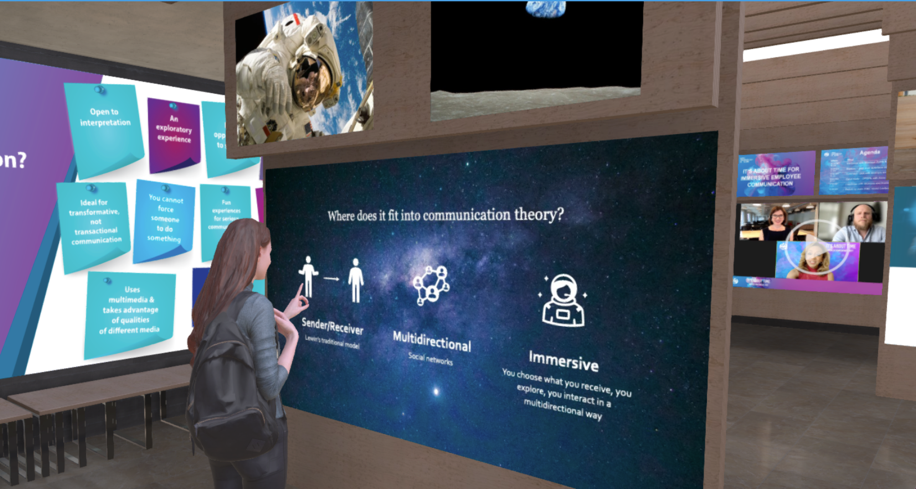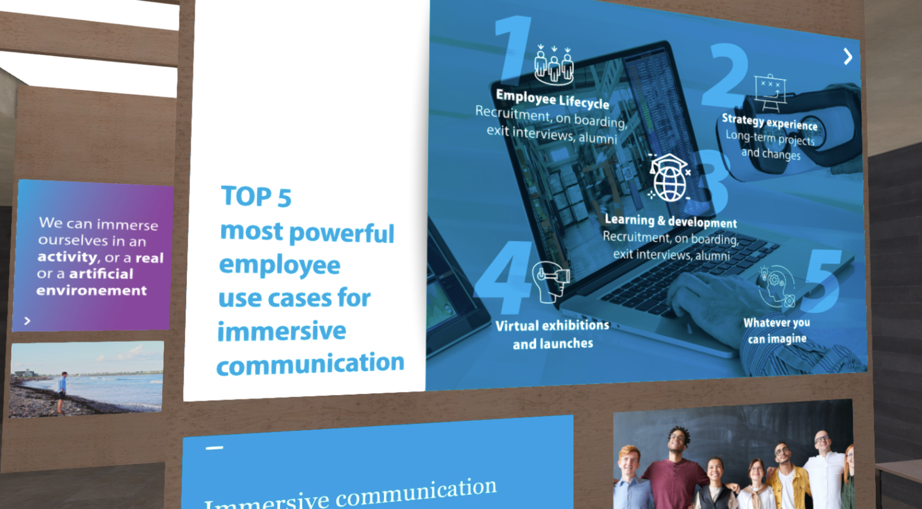At the virtual IABC World Conference 2021, presenter Monique Zytnik shared new, 3D possibilities for employee communication. Read on for a deep dive of Zytnik’s presentation, and visit the IABC website to purchase World Conference recordings or the All-Access Pass.
The new kid on the block is immersive communication. It’s a new mindset of how we plan and create corporate communications. The implications are extremely exciting from both a communications theory and practical employee engagement perspective. New 3D environment technology, which is accessible for employees, adds a whole new dimension to communication we can offer our colleagues in an immersive, virtual space.
Take a quick look at the highlights from the IABC World Conference 2021 immersive communication session to understand what it is all about.
What Is Immersive Communication?
Being immersed in an activity, in a real or virtual environment, is about being in the moment. Immersive communication is a multichannel, multisensory experience – what you see and what you hear. It is about communicating in a nonlinear, exploratory way, where your visitor or audience are free to choose what they want to interact with and how they want to consume content and take control.
Immersive communication experiences are perfect for adding gamification and interaction. Immersive communication is an experienced based approach, rather than a channels based approach.

Delving Into Digital 3D Environments
We’ve been working with desktop-based 3D environments to engage employees on corporate strategy, recruitment and anything that involves bringing fun, curiosity and choice into a wide range of topics.
A lot of people hear “3D” and imagine wearing a big clunky headset, using hand controllers and doing strange, spacewalk movements around the room.
This is certainly not the case. Desktop 3D is perfectly fine.
We can create wow-factor, functional 3D experiences designed for desktop and laptop computers. It is a little like playing a simplified version of Minecraft, where you use the keyboard and mouse to interact and maneuver the space. The desktop’s screen size allows for a better viewing experience of brochures and PDFs, and thanks to better processing speeds, computers add a bit more to the graphics’ quality.
This is perfect for the employee experience where, from a corporate perspective, there simply isn’t budget to outfit and train every employee to use a headset and controllers. Internet speed is the main challenge to watch out for, particularly when your employees might be in countries or places with unstable networks.
From a broader perspective, immersive communication technology — which includes virtual and augmented reality — is a trend to keep a close eye on. For example, Fortune Business Insights estimates that the global virtual reality market will grow to $57.55 billion (£40.19 billion) by 2027, up from just $3.1 billion (£2.24 billion) in 2019.
Will Immersive Spaces Replace the Intranet?
Immersive spaces are not a replacement of intranets or real events, but rather an addition. As with all channels, they have inherent qualities and are best suited to certain types of content.
Perfect use cases are strategy environments, recruitment and onboarding with a learning and development element. Immersive spaces can even work for project communications — for example, building a new hospital — where many stakeholders need to be engaged in a non-threatening, desire-creating way.
Because immersive communication has an exploratory nature, directive or time-sensitive communication is not ideal for this environment unless you are streaming into the space and using it for a virtual event. For people to explore, they need to feel safe and not rushed, otherwise they are less likely to interact with and absorb the content.

Rethinking Content Into an Experience-Focused Mindset
Perhaps the most interesting part of immersive communication is realizing that people truly do experience things differently. Converting content from a 2D environment such as posters or intranet content into 3D is a different way of thinking about content.
Your visitor could start at the front or back of the space and then move to the left or right. You give them the choice, and you need all the messages to make sense on their own, whilst contributing to the whole picture.
This is particularly interesting when starting to put content into a space. When I first started working with digital immersive experiences, I realized that what looks good in a 2D environment, such as a photo or poster, can look completely different in a 3D environment. For example, I collaborate with visual designers on writing size. Text needs to have a decent contrast and be both large enough and minimal enough to make sense from several different angles. The visual designer also needs to think about and the content as a whole to ensure there is a consistent look and feel.
Audio Is the Undiscovered Gem
In employee communications, we haven’t yet fully explored what audio can do. In an experiential environment, audio becomes much more important because it helps set the tone and feeling of the environment.
As the host for the IABC EMENA Region podcast, I’ve become more aware of the value of sound and the qualities it can bring to communications. In the virtual space, there are challenges of making sure the audio environment doesn’t become cluttered and that an audio file adds to the experience. I’ve typically focused on including different voices in the space to reflect the different employees an organization might have. Being in Europe, I greatly appreciate the range of accents available and the richness they add to an experience.
Don’t Forget the Data and Analytics
Web analytics can be implemented into the space so you can see what content your visitors are engaging with. For example, when clients contact virtual tours, run a promotion campaign or hold an event, it is easy to see the resulting increase (or decrease) in numbers.
Other data such as interactive games completion rates, survey completion, survey feedback and numbers can build a picture of how your people are engaging and experiencing your space. User testing will give you additional, rich data that is fascinating to conduct so you can ensure you are optimizing.

The Sky Is the Limit
Custom creation of an immersive communication experience means you can think big. What can be created is only limited by imagination and, to some extent, budget. This is hugely exciting, as you can create spaces and experiences that are impossible to build in real life.
Immersive communication is still developing. I encourage you to watch this space.
Listen to this audio clip to experience immersive communication. See a transcript of the audio below.
Hi this is Monique Zytnik from Open Communication, and I hope you enjoyed learning about immersive communication. I think it is such an exciting, emerging opportunity for employee engagement. Please reach out if you have any questions, I’d love to hear what you think and don’t forget to check out our IABC EMENA Region podcast, available on SoundCloud, iTunes and Spotify.
Monique ZytnikMonique Zytnik is the global employee communication SME at Open Communication. She serves as the IABC EMENA Region Vice Chair.